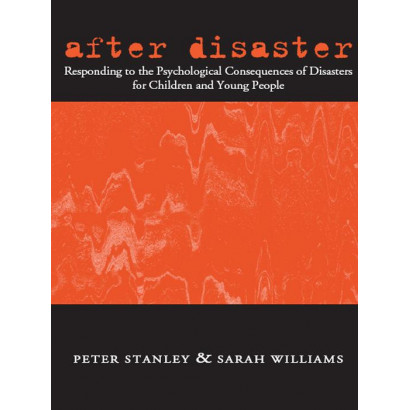After Disaster
This book discusses responses to the psychological consequences of disasters for children and young people.
Children and young people are the focus of this book. In many ways, their reactions to disaster may be similar to those of adults. However, thedevelopmental and age-related needs of children and adolescents mean that the impact on them can be different.
After Disaster is intended as a psychological first aid guide. It provides critical understanding and information about children’s reactions and how to respond to them with psychological knowledge beyond the obvious.
From: After Disaster, by Peter Stanley and Sarah Williams
A. How are students affected psychologically by disaster?
Disasters can affect how students think, feel and act. However, it is important to understand that students will respond to disaster in different ways and within different time periods. Teachers should not assume that particular responses will inevitably follow a disaster. Nor should they assume that all student distress after a disaster is automatically related to that event.
Nevertheless, teachers are likely to see some common behaviours and responses resulting from disaster or disaster-related disruptions in family life. Students may worry if they begin to experience some of these. They need to be reassured that what they are feeling is an understandable reaction to an abnormal situation.
Although few students will exhibit a large number of the symptoms discussed here, it is crucial to be able to identify, quickly and accurately, those students who have been significantly traumatised. Knowing each student’s usual pattern of responding to stress, and being able to take their individual situation into account, are obviously helpful.
While symptoms displayed by young people may be a response to a disaster or disaster-related disruption, they may also reflect conditions that were present before the disaster. The stresses and strains caused by the disaster may reveal or worsen pre-existing difficulties.
Changes in thinking
Following disaster, there are some common ways in which students’ thinking — their cognitive reactions — may change.
Re-experiencing the disaster
Many students are troubled by repetitive and intrusive thoughts about the disaster. These thoughts often concern a specific vivid image or sound related to the disaster or its aftermath. These thoughts may occur at any time, but they are particularly likely to come up when the young person is quiet or trying to fall asleep. At other times the distressing thoughts may be triggered by something in the environment that reminds the student of the disaster.
Memory disturbances
Disasters do not usually result in severe long-term memory loss for students. However, some students experience more general memory problems. For example, they may have difficulty memorising new material, or remembering old skills such as reading music. Not being able to memorise new material may affect their progress at school.
Students may show several types of memory distortions related to the disaster itself. When they recall the events, they may play down the threat to their own lives. For instance, they may leave out moments of extreme danger, or not mention their own injuries.
Students may also become confused about the sequence of events. As well, they may start to feel that there were “omens” or premonitions of it, such as stepping in a bad luck square. One boy reported that ten days before an earthquake his uncle had said “we will all die together”.
Decline in school performance
Students may show a decline in school performance after a disaster. Disruption and breaks in schooling may be significant contributors to this. Children may also have problems concentrating on schoolwork because of intrusive thoughts about the disaster, or lack of sleep.
Sense of a foreshortened future
Students may express limited expectations about their future. This could include a belief that they will never marry, have children, have a successful career, or even live beyond a certain age.

